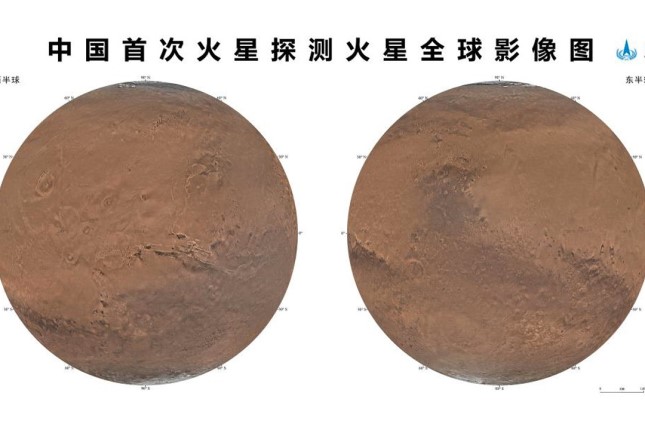China on Monday released the first Mars global images obtained from its first Mars exploration mission, providing an improved quality base map for scientific and exploration tasks on the Red Planet, the Global Times learned from the China National Space Administration (CNSA) at the opening ceremony of this year's Space Day of China.
The color images, jointly issued by the CNSA and the Chinese Academy of Sciences (CAS), included orthographic, Robinson, Mercator and azimuthal projections of the eastern and western hemispheres of Mars with a spatial resolution of 76 meters.
The image maps will provide an improved quality base map for Mars exploration projects and scientific research, the CNSA said, and data obtained by the Tianwen mission will make key contributions to humanity's in-depth knowledge of the planet.
The medium-resolution camera onboard Tianwen-1 took 284 orbital remote sensing images from November 2021 to July 2022, so as to achieve global coverage of the Martian surface. Some 14,757 images were acquired by the ground-based application system, which were then processed to obtain the global color image map of Mars.
China's panoramic map of Mars is one of the most advanced in the field that is open to the public, experts noted, and it means that China is willing to share cutting-edge technology and information with its peers.
"This year's China Space Day underscores our willingness to share information with the world, showing that China's space achievements are entirely for the development of human scientific and technological progress. It also suggests our growing confidence in this field," Song Zhongping, a space analyst and TV commentator, told the Global Times on Monday.
"Technology has no borders, but the US has been constantly putting up shields and fences to block others from its technology, as well as engaging in technological monopolies, information hegemony and a Cold War in space," he said.
At the opening ceremony on Monday, the CNSA also disclosed that 22 sites on Mars have been given Chinese names.
China's research teams have identified a large number of geographical entities near the landing site of Tianwen through high-resolution images, and the International Astronomical Union has named 22 of them after villages in China with historical and cultural significance and a population of less than 100,000.
In this way, China's presence is permanently engraved on Mars' surface.
Tianwen-1, China's first Mars mission probe, embarked on its journey on July 23, 2020, and after 202 days of travel, it began to orbit Mars. On May 15, 2021, the land rover Zhurong landed in a designated spot on the Martian surface and started its trek. It completed its 90-Martian-day scientific exploration task and kept working for another 268 Martian days, and has remained in hibernation mode since.
As of June 29, 2022, the Mars orbiter had carried out global remote sensing for more than 1,000 days, and it is still carrying on its mission in fine condition.
China's first Mars mission, which orbits Mars, land and rove in one go, was completed successfully.
The 13 payloads carried by the mission have accumulated 1,800 gigabytes of scientific data and formed standard data products.
Over the past two years, Tianwen-1 has obtained first-hand detection data and achieved notable scientific research results, which analysts said would be continued with further multi-dimensional exploration missions being carried out.
In May 2022, a research team from the CAS detected water-bearing minerals on Mars by analyzing data collected by the Zhurong rover, marking a world first that water-bearing minerals on the planet were detected by a short-wave infrared spectrometer on a Mars rover. The findings have been published in detail in the journal Science.
Another major discovery by the Chinese Mars rover came when scientists used a ground-penetrating radar on Zhurong to find possible evidence of floods on the Red Planet billions of years ago. Though no direct evidence for liquid water was found in the shallow subsurface, the study lends weight to the theory that the rover's landing area - the Utopia Planitia - once hosted an ancient ocean, researchers from the CAS and Peking University said in a Nature paper published in September 2022.
Photo: An orthographic projection of the eastern and western hemispheres of Mars © CNSA.
Source: The Global Times.
































